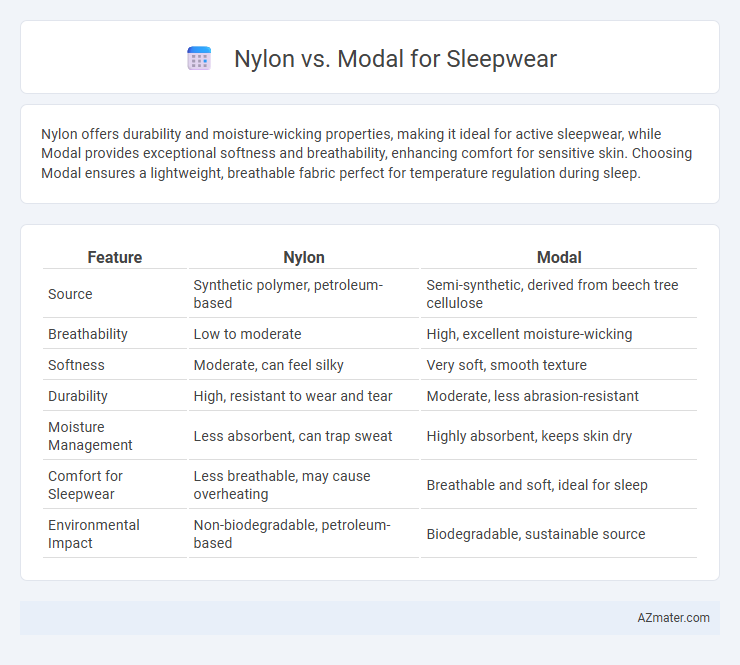Nylon offers durability and moisture-wicking properties, making it ideal for active sleepwear, while Modal provides exceptional softness and breathability, enhancing comfort for sensitive skin. Choosing Modal ensures a lightweight, breathable fabric perfect for temperature regulation during sleep.
Table of Comparison
| Feature | Nylon | Modal |
|---|---|---|
| Source | Synthetic polymer, petroleum-based | Semi-synthetic, derived from beech tree cellulose |
| Breathability | Low to moderate | High, excellent moisture-wicking |
| Softness | Moderate, can feel silky | Very soft, smooth texture |
| Durability | High, resistant to wear and tear | Moderate, less abrasion-resistant |
| Moisture Management | Less absorbent, can trap sweat | Highly absorbent, keeps skin dry |
| Comfort for Sleepwear | Less breathable, may cause overheating | Breathable and soft, ideal for sleep |
| Environmental Impact | Non-biodegradable, petroleum-based | Biodegradable, sustainable source |
Introduction to Nylon and Modal Fabrics
Nylon, a synthetic fiber derived from petrochemicals, is known for its durability, elasticity, and moisture-wicking properties that make it suitable for sleepwear. Modal, a semi-synthetic fabric made from beech tree cellulose, offers exceptional breathability, softness, and eco-friendliness, enhancing comfort during sleep. Understanding the distinct characteristics of nylon and modal fibers helps in selecting sleepwear that balances durability with natural comfort.
Key Characteristics of Nylon Sleepwear
Nylon sleepwear is known for its durability, lightweight feel, and excellent moisture-wicking properties, making it ideal for maintaining comfort throughout the night. Its synthetic fibers provide strong resistance to wear and tear, ensuring long-lasting use even with frequent washing. Nylon also offers a smooth texture and quick-drying capability, enhancing breathability and preventing discomfort caused by sweat.
Key Characteristics of Modal Sleepwear
Modal sleepwear is highly breathable and moisture-wicking, offering superior comfort by keeping the skin dry throughout the night. Its smooth, silky texture provides a soft touch against the skin, enhancing sleep quality and reducing irritation. Modal fabric is also durable and resistant to shrinkage, maintaining its shape and softness even after multiple washes, making it an excellent choice for long-lasting sleepwear.
Comfort and Softness Comparison
Modal fabric offers superior softness compared to nylon, making it an ideal choice for sleepwear that prioritizes comfort. Modal, derived from beech tree pulp, is breathable and moisture-wicking, providing a gentle, smooth texture that feels soothing against the skin. Nylon, while durable and stretchy, can feel less breathable and slightly synthetic, often leading to reduced comfort during prolonged wear.
Breathability and Moisture Management
Modal, derived from beech tree pulp, offers superior breathability and moisture-wicking properties compared to nylon, making it ideal for sleepwear that keeps the skin dry and comfortable throughout the night. Nylon, a synthetic polymer, tends to trap heat and moisture, resulting in less ventilation and potential discomfort during sleep. Modal's natural fibers enhance airflow and effectively absorb moisture, promoting a cooler and more breathable sleep environment.
Durability and Longevity
Nylon offers exceptional durability and resistance to wear, making it highly suitable for long-lasting sleepwear that maintains its shape and strength after multiple washes. Modal, a semi-synthetic fiber made from beech tree pulp, provides softness and breathability but tends to be less resistant to abrasion and pilling compared to nylon. For sleepwear requiring extended longevity and robust performance, nylon garments typically outperform modal in maintaining fabric integrity over time.
Skin Sensitivity and Allergen Concerns
Modal fabric, made from beech tree pulp, is naturally hypoallergenic and highly breathable, making it ideal for individuals with sensitive skin or allergies. Nylon, a synthetic material, can trap heat and moisture, potentially irritating sensitive skin and increasing the risk of allergic reactions. Sleepwear crafted from modal minimizes skin irritation and promotes comfort, while nylon may cause discomfort for users prone to skin sensitivities.
Care and Maintenance Requirements
Nylon sleepwear requires gentle washing in cold water and air drying to prevent fabric damage and maintain elasticity. Modal fabric benefits from machine washing on a gentle cycle with mild detergent and should be dried flat or tumble dried on low to avoid shrinkage. Both materials demand minimal ironing, with modal being more resistant to wrinkles and nylon requiring delicate handling to preserve its smooth texture.
Sustainability and Environmental Impact
Modal sleepwear, made from beech tree pulp, offers a more sustainable option compared to nylon, as it is biodegradable and derived from renewable resources. Nylon production relies heavily on petrochemicals, contributing to higher carbon emissions and non-biodegradable waste, thus posing significant environmental challenges. Choosing modal fabric reduces ecological footprint due to its lower water consumption and eco-friendly manufacturing processes.
Which Fabric Is Best for Your Sleepwear?
Nylon offers durability, moisture-wicking properties, and a smooth texture making it ideal for sleepwear that prioritizes longevity and breathability. Modal, derived from beech tree pulp, provides exceptional softness, excellent moisture absorption, and a lightweight feel, ensuring comfort and temperature regulation during sleep. Choosing between nylon and modal depends on whether you value a high-performance synthetic fabric or a natural, eco-friendly material for your sleepwear.

Infographic: Nylon vs Modal for Sleepwear
 azmater.com
azmater.com